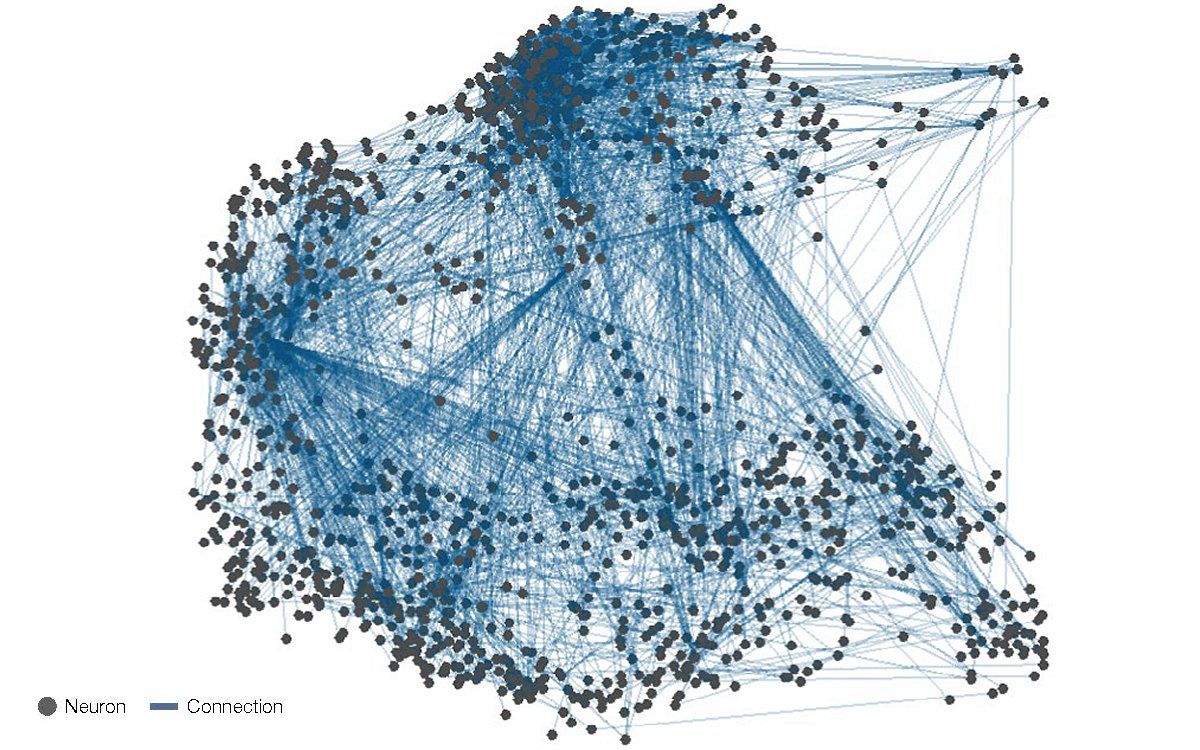In neuroscience—as in geography, genomics, and plenty else—it’s hard to navigate without a good map. Recent advances in brain mapping technologies have enabled scientists to create larger and more detailed models. And as those models for different animals are compared, some surprising similarities have cropped up. So much so that these neurological connection maps (a.k.a. “connectomes”) may inform the designs of advanced neuromorphic electronics: chip and algorithmic models that seek to mimic the computational power and efficiency of brains and neurons.
Scientists at Yale, Princeton, and the University of Chicago seized the 2021 publication of the fruit-fly connectome—a landmark in the emerging field of connectomics—as their opportunity to compare aspects of brain structure across widely different size and complexity scales.
Mapping out a connectome is no small feat, says Christopher Lynn, assistant professor of physics at Yale. Even a species as minuscule as the fruit fly represents a substantial neurological challenge. Fruit-fly brains comprise a network of over 120,000 neurons with more than 30 million connections among them. Which, for the purpose of a connectome, means each connection must somehow be isolated, recognized, and graphed.
How C. elegans mapped the way
“For a sense of scale, C. elegans [the nematode worm] has only 302 neurons,” Lynn says. “They mapped out the entire connectome for the first worm in the ’80s, and that was a big breakthrough,” says Lynn. “Each neuron might have between 100 to 10,000 synapses in the case of the fruit fly. When you get to larger systems, you’re tracking hundreds of thousands or millions of synapses.”
“There is a simple phrase they say when teaching this: ‘If two neurons fire together, they are likely to wire together.’ ” —Christopher Lynn, Yale University
The researchers found persistent connectivity statistics across five different connectomes scaling from the simple C. elegans nematode to the retina of a mouse. They used what’s called heavy-tailed statistics—recognizing that while most connections between neurons are weak, a small number of those connections are much stronger. This result complements prior work showing that brain networks tend to show “small-world“ characteristics: a small number of neurons are connected to many other neurons, but most neurons aren’t connected to very many at all.
The presence of heavy-tailed connectivity across species indicates that some of the same principles of neural function may also bridge across organisms of entirely different scales. To help provide a possible framework, the team created a model of brain development that weighed random reorganization with what neuroscientists call Hebbian plasticity, or the tendency of nearby, concurrently active neurons to connect to each other. “There is a simple phrase they say when teaching this: ‘If two neurons fire together, they are likely to wire together,’ ” says Lynn. The model, though a simple approximation of how neurons in a brain may come together, consistently recreated the heavy-tailed distributions Lynn and his colleagues saw across connectomes.
Brain maps inspire neuromorphic hardware
The researchers’ discovery of cross-species connectome similarities could pave the way for new neuromorphic hardware. For instance, the heavy-tailed connectivity patterns they studied suggest a productive line of inspiration for chip design.
“There are details that are different, but the heavy-tailed shape is consistent across animals and brain regions.” —Christopher Lynn, Yale University
Mike Davies, director of Intel’s Neuromorphic computing laboratory, says that small-world connectivity patterns are an attractive feature to model one’s design ideas after. “There’s a tendency to want to simplify the connectivity in a neuromorphic chip to what you can conveniently fabricate,” says Davies. “To represent all possible connections is an n-squared explosion.”
He adds, however, that Intel has taken a slightly different approach to its neuromorphic designs than strictly following nature’s lead. Instead of trying to explicitly build dense networks in the chips themselves, the company is using adaptive networking systems that route the networking traffic. “It’s the most efficient system we have for modeling these sparse connections,” says Davies. “With that, we actually can replicate some of these heavy-tailed networks.”
Looking forward, Lynn says the connectomics team will now expand the list of species whose connectomes they map. While the cell-level mouse connectome used in the present study was limited to the animal’s retina, Lynn says the researchers also observed similar heavy-tailed connectivity in much larger parts of the mouse brain.
While the team’s present results are limited to a handful of connectomes, Lynn says he expects their results will be recapitulated for the connectomes of even larger and more complicated brains. “Based on literally every dataset we’ve seen so far, this distribution looks similar across all of them,” he says. “I would expect these heavy-tailed distributions to be pretty ubiquitous across brains generally.”
The researchers published their results earlier this month in the journal Nature Physics.
Michael Nolan is a writer and reporter covering developments in neuroscience, neurotechnology, biometric systems and data privacy. Before that, he spent nearly a decade wrangling biomedical data for a number of labs in academia and industry. Before that he received a masters degree in electrical engineering from the University of Rochester.



